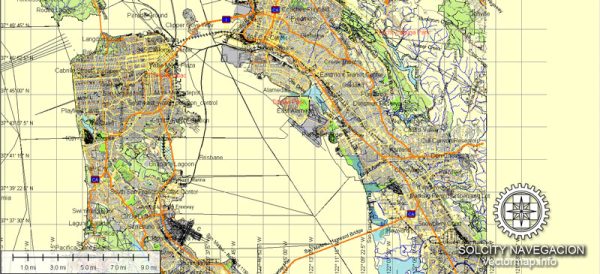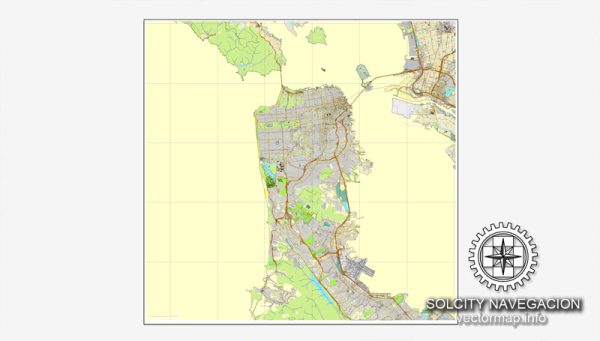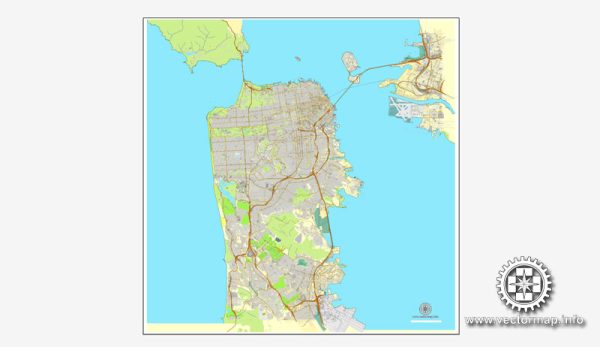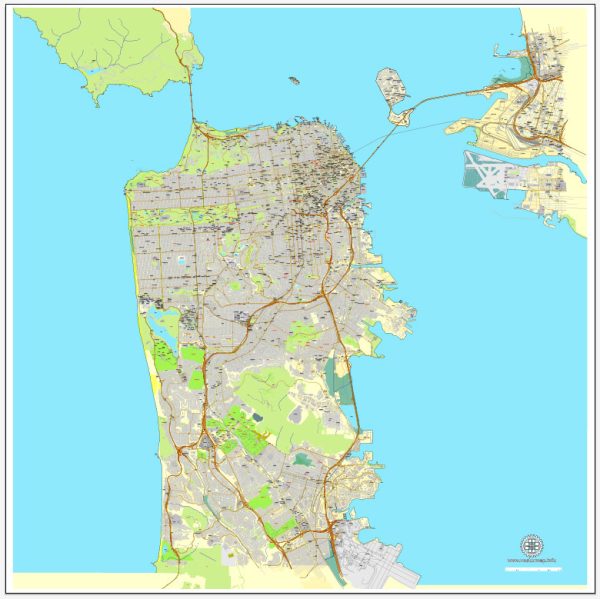San Francisco, California, has a rich political and economic history that spans several centuries.
Vectormap.Net provide you with the most accurate and up-to-date vector maps in Adobe Illustrator, PDF and other formats, designed for editing and printing. Please read the vector map descriptions carefully.
Here’s a detailed overview of its key historical milestones:
Indigenous Peoples and Early Settlement:
- Pre-European Arrival: Before European colonization, the San Francisco Bay Area was inhabited by various Indigenous peoples, including the Ohlone tribes.
- Spanish Colonization: In 1776, the Spanish established the Presidio of San Francisco and the Mission San Francisco de Asís (commonly known as Mission Dolores). These were part of Spain’s efforts to colonize Alta California.
Mexican Era:
- Mexican Rule: Following Mexico’s independence from Spain in 1821, California became a Mexican territory. The Mexican land grant system resulted in large ranchos, and the land that would become San Francisco was granted to various individuals.
Gold Rush and Rapid Growth:
- Gold Rush (1848–1855): The discovery of gold at Sutter’s Mill in 1848 sparked the California Gold Rush, drawing people from around the world to the area. San Francisco’s population exploded, and it quickly transformed from a small settlement to a bustling city.
- City Incorporation: San Francisco was officially incorporated as a city in 1850.
Economic and Maritime Hub:
- Shipping and Trade: San Francisco’s natural harbor made it a vital port for shipping and trade. The completion of the First Transcontinental Railroad in 1869 further boosted economic growth.
- Chinatown: The city attracted a diverse population, including a significant Chinese immigrant community that played a crucial role in the development of Chinatown.
- Earthquake and Fire (1906): A devastating earthquake and subsequent fires in 1906 caused widespread destruction. However, the city quickly rebuilt, and the disaster led to improved building codes.
Post-World War II Era:
- Naval and Industrial Activity: During World War II, San Francisco played a key role as a naval base and shipbuilding center. After the war, it became a hub for various industries.
- Cultural Movements: The city became a focal point for countercultural movements in the 1960s, including the Summer of Love in 1967, centered in the Haight-Ashbury neighborhood.
Tech Boom and Economic Transformation:
- Silicon Valley Influence: In the latter half of the 20th century, San Francisco became closely tied to the rise of Silicon Valley, home to numerous technology companies and startups.
- Financial District: The city’s Financial District developed into a major financial center, hosting the headquarters of major banks and financial institutions.
Contemporary Challenges and Changes:
- Housing Crisis: In recent decades, San Francisco has faced challenges related to skyrocketing housing costs and homelessness, driven in part by the tech industry’s growth.
- Tech Boom and Gentrification: The influx of tech companies and professionals has led to gentrification in some neighborhoods, impacting the socio-economic landscape.
Political Landscape:
- Progressive Traditions: San Francisco has a history of progressive politics, with a focus on civil rights, environmentalism, and social justice.
- LGBTQ+ Rights: The city has been a trailblazer in LGBTQ+ rights, and the Castro district is known as a historic LGBTQ+ neighborhood.
In summary, San Francisco’s political and economic history is marked by its transformation from a Spanish-Mexican outpost to a thriving Gold Rush city and later a global center for technology and finance. The city has faced challenges but continues to be a dynamic and influential hub on the West Coast.





 Author: Kirill Shrayber, Ph.D.
Author: Kirill Shrayber, Ph.D.